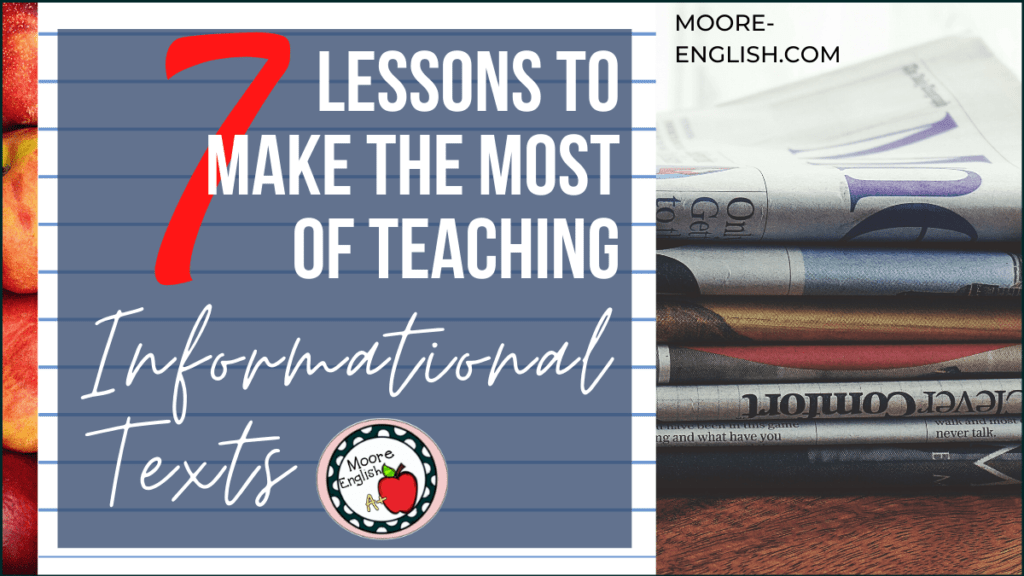I have to admit: informational texts are not what drew me to teaching language arts. My first loves are literature and poetry. But years of teaching ELA have helped me understand the relevance and value of informational texts. Reading and annotating informational and nonfiction texts provides significant value to students. For students, nonfiction texts are relevant and engaging. Further, these 8 skills fit perfectly with teaching informational texts.
This post this post may contain affiliate links. Please read the Terms of Use.
Interacting with Informational Texts
Approaching an informational text is different from interacting with other types of texts. In particular, annotating an informational text requires a unique set of skills. My students work through these 4 steps to annotate any nonfiction or informational text. These are the set of resources designed to help students annotate nonfiction texts.
In addition, informational texts are a great place for teaching the importance of text features. Since text features are part of a text’s structure, they can provide students with important insights into author’s purpose. Similarly, since text features are designed for the benefit of the reader, students can gain insights into how the author intended readers to approach a text. Here are some favorite resources and ideas for teaching text features:
- Text Features Concentration
- 30 Research and Nonfiction Texts Task Cards
- Ideas and Inspiration for Teaching Text Features
Interrogating the Author
One of the advantages of teaching informational texts is the opportunities they provides for evaluating author’s purpose. Here are several opportunities for considering the role of the author in informational texts:
Author’s Credibility
In producing an informational text, authors have to conduct research. For this reason, reading an informational text in class is a great way to challenge students to consider an author’s credibility. Similarly, students can also determine whether or not an author is biased in their approach to a text or topic. Some texts to use when considering author’s credibility include:
- Consider JFK’s status in relation to his purpose when reading “The Immigrant Contribution,” an excerpt from A Nation of Immigrants
- Similarly, evaluate Patrick Henry’s ability to gain credibility as a speaker by drawing on the ethos of previous speakers
- Evaluate the reasons Chimamanda Ngozi Adichie is uniquely qualified to speaker to “The Danger of a Single Story”
Author’s Point of View
In addition to evaluating an author’s credibility, informational texts are also a great opportunity for teaching or reviewing point of view. Point of view is always important in reading. But the point of view of an informational text can be particularly telling. Here are some questions students can consider in regards to point of view:
- Is the text written in first person? How does the use of first person relate to the text’s objectivity? Does the use of the first person compromise the text or create bias?
- Is the text written in the third person objective? Does the use of the objective prevent bias? How does its use further the author’s purpose?
Author’s Tone
In many ways, author’s tone is where credibility, point of view, and purpose intersect. For my students, tone is often a stumbling block. So it’s important to consistently practice and evaluate tone when reading informational texts. When students are working to evaluate tone, they should consider the following:
- Does the text use verbal irony? And does the author use “quotations” or italics to convey irony?
- Does the author use passive voice to limit their personal bias?
- What role do adjectives and adverbs play in text? Does the author use figurative language or literary devices in the writing?
Author’s Use of Rhetoric
In persuasive texts, students will also encounter rhetoric. The use of rhetoric is closely related to point of view and tone. And the use of rhetoric can elevate or denigrate an author’s credibility. Either way, rhetoric can be a complicating factor in interrogating informational texts. Here are some tools and texts ideal for teaching rhetoric:
- Rhetoric Card Sort
- 30 Rhetoric Task Cards
- “Words and Behavior” by Aldous Huxley
- “Credo: What I Believe” by Neil Gaiman
Synthesis and Informational Texts
For students, synthesis is challenging skill. The brevity of informational texts can provide teachers with an opportunity to practice synthesis in the classroom.
Firstly, historical context is of critical importance in understanding informational texts. The time period in which a text was written and published can have a profound effect on a text’s meaning and reception. Here are some pieces that work as mentor texts for evaluating the impact of historical context:
- “Privileged” by Kyle Korver
- “The Crisis No. 1” by Thomas Paine
- “Sinners in the Hands of an Angry God” by Jonathan Edwards
- “Of Our Spiritual Strivings” from The Souls of Black Folk by W.E.B. Du Bois
Two of the most challenging Common Core ELA standards are RI 9-10.7 and 11-12.7. These standards are challenging because they ask students to evaluate how medium affects meaning. Because of their relationship with historical context, informational texts often appear in multiple forms. Here are some options for evaluating the relationship between medium and meaning in informational texts:
- Compare primary and secondary accounts of the same event.
- Read the transcript of a TED talk and compare it to the video.
- Listen to a podcast and compare it to a print interview from the same speaker.
- Read a movie or book review and compare it to the item being reviewed.
- Evaluate an expository text and compare it to an infographic of the same information.
- Read a campaign speech and watch a political advertisement or review a campaign poster.










